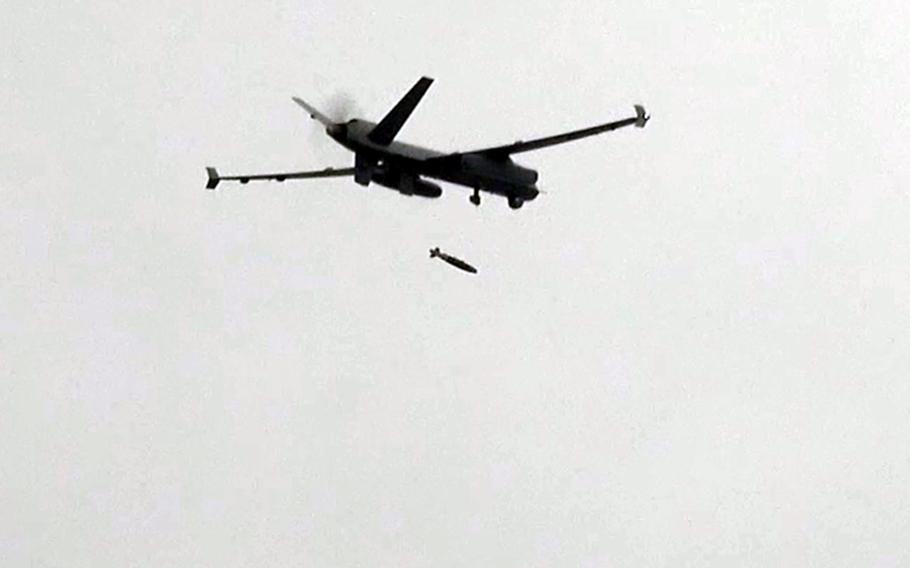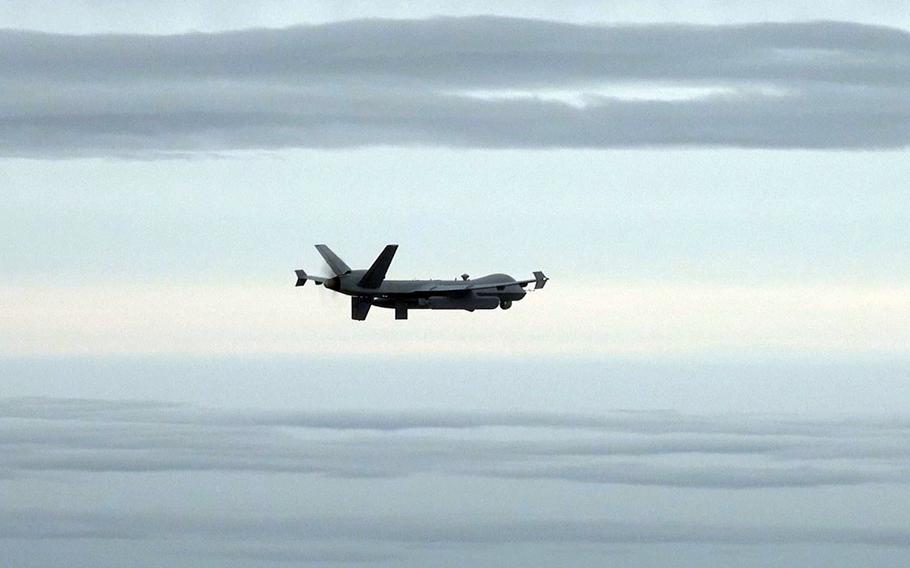
A U.S. Air Force MQ-9 Reaper drops an inert GBU-38 Joint Direct Attack Munition, or JDAM, over Jikdo Island, South Korea, Nov. 1, 2024. (South Korean air force)
SEOUL, South Korea — Unmanned aerial vehicles from the United States and South Korea recently teamed up to improve their combat effectiveness via first-of-their-kind live-fire drills, according to the Ministry of National Defense in Seoul.
The training took place Friday, a day after North Korea fired an intercontinental ballistic missile off its eastern coast, although the timing is unrelated, according to email Monday from 7th Air Force spokeswoman Master Sgt. Rachelle Coleman.
A U.S. Air Force MQ-9 Reaper dropped an inert, 558-pound GBU-38 Joint Direct Attack Munition, or JDAM, using reconnaissance data from a South Korean air force RQ-4B Global Hawk, according to Coleman and a ministry news release three days earlier.
The Air Force includes the dropping of inert, or dummy bombs, in its definition of live fire.
Coleman declined to provide further details about the flight, citing operational security concerns.
The exercise took place on Jikdo Island in the Yellow Sea, approximately 30 miles southwest of Seoul, a South Korean air force spokesman said by phone Monday. South Korean officials customarily speak to the media on condition of anonymity.
The U.S. and South Korean militaries routinely exercise on Jikdo. In June, special operations troops practiced close air support and aerial interdiction with an Air Force AC-130J Ghostrider gunship on the island.

A U.S. Air Force MQ-9 Reaper takes part in live-fire training over Jikdo Island, South Korea, Nov. 1, 2024. (South Korean air force)
After North Korea launched a ballistic missile over Japan on Oct. 3, 2022, U.S. F-16 Fighting Falcons and South Korean F-15K Slam Eagles dropped JDAMs on a target on the island the next day.
Friday’s live-fire training took place a day after North Korea fired an intercontinental ballistic missile off its eastern coast. The ICBM flew 620 miles at a maximum altitude of 4,776 miles before splashing down in the Sea of Japan, or East Sea, according to North Korea’s state-run Korean Central News Agency.
The U.S. approved the $657 million sale of four Global Hawks to South Korea in 2014; the last of the drones was delivered six years later. The drones are primarily used for surveillance and can fly for up to 30 hours at a maximum altitude of 60,000 feet, according to the Air Force’s website.
South Korean President Yoon Suk Yeol’s office in May said the military planned to double its drone fleet in the next two years.
South Korea’s Defense Acquisition Program Administration, in a $353 million contract in December, tasked three Seoul-based defense firms with mass producing medium-altitude UAVs that can fly at an altitude of about six to seven miles.
The military created a new command tasked with overseeing drone operations in the country in September 2023. The Drone Operations Command headquartered in Pocheon, about 15 miles from the heavily guarded Demilitarized Zone, was established nine months after Pyongyang flew approximately five drones into the South’s airspace.
North Korea’s drone incursion into the South, the first of its kind in five years, prompted Seoul to scramble fighters and helicopters in an unsuccessful attempt to intercept the aircraft.
Stars and Stripes reporter Yoo Kyong Chang contributed to this report.